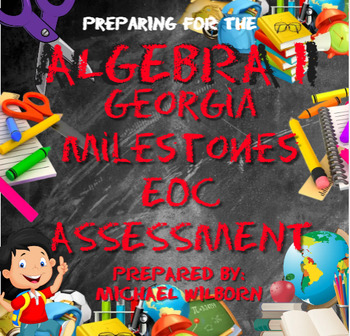Algebra 1 Spring 2024 Georgia Milestones Assessment Handbook
Alabama ACAP Ga Milestone Instructional Supports
122 Followers
Grade Levels
8th - 9th
Subjects
Resource Type
Standards
CCSS8.EE.A.1
CCSS8.EE.A.2
CCSS8.EE.A.3
CCSS8.EE.A.4
CCSS8.EE.B.5
Formats Included
- Google Docs™
Pages
60 pages
Alabama ACAP Ga Milestone Instructional Supports
122 Followers

Made for Google Drive™
This resource can be used by students on Google Drive or Google Classroom. To access this resource, you’ll need to allow TPT to add it to your Google Drive. See our FAQ and Privacy Policy for more information.
Description
This Booklet Includes:
- Useful websites for tools and practice questions as well as lesson plans and resources to support teaching
- A website with access to a glossary with key vocabulary terms defined with visuals
- Algebra I Formula Sheet that will be used on the Assessment
- Which Standards will be tested on the Georgia Milestones
- Where those Standards are Located in Your Envision 2.0 Textbook
- A Draft Version of what the Achievement Level Descriptors for each Standard
- How many points will be awarded for each question/standard
- The Percentage of the Test that each standard counts
- DOK Level of Questions
- DOK Levels Defined
- Algebra I Curriculum Map to best teach your students the standards
- This handbook is a combination of everything that the Georgia State Dept. of Education has published concerning the Georgia Milestones End of Grade Assessment for Algebra I: All of this information is available for free on their website. I have just combined it into one easy to read booklet.
Total Pages
60 pages
Answer Key
Does not apply
Teaching Duration
1 Year
Report this resource to TPT
Reported resources will be reviewed by our team. Report this resource to let us know if this resource violates TPT’s content guidelines.
Standards
to see state-specific standards (only available in the US).
CCSS8.EE.A.1
Know and apply the properties of integer exponents to generate equivalent numerical expressions. For example, 3² × (3⁻⁵) = (3⁻³) = 1/3³ = 1/27.
CCSS8.EE.A.2
Use square root and cube root symbols to represent solutions to equations of the form 𝘹² = 𝘱 and 𝘹³ = 𝘱, where 𝘱 is a positive rational number. Evaluate square roots of small perfect squares and cube roots of small perfect cubes. Know that √2 is irrational.
CCSS8.EE.A.3
Use numbers expressed in the form of a single digit times an integer power of 10 to estimate very large or very small quantities, and to express how many times as much one is than the other. For example, estimate the population of the United States as 3 × 10⁸ and the population of the world as 7 × 10⁹, and determine that the world population is more than 20 times larger.
CCSS8.EE.A.4
Perform operations with numbers expressed in scientific notation, including problems where both decimal and scientific notation are used. Use scientific notation and choose units of appropriate size for measurements of very large or very small quantities (e.g., use millimeters per year for seafloor spreading). Interpret scientific notation that has been generated by technology.
CCSS8.EE.B.5
Graph proportional relationships, interpreting the unit rate as the slope of the graph. Compare two different proportional relationships represented in different ways. For example, compare a distance-time graph to a distance-time equation to determine which of two moving objects has greater speed.


